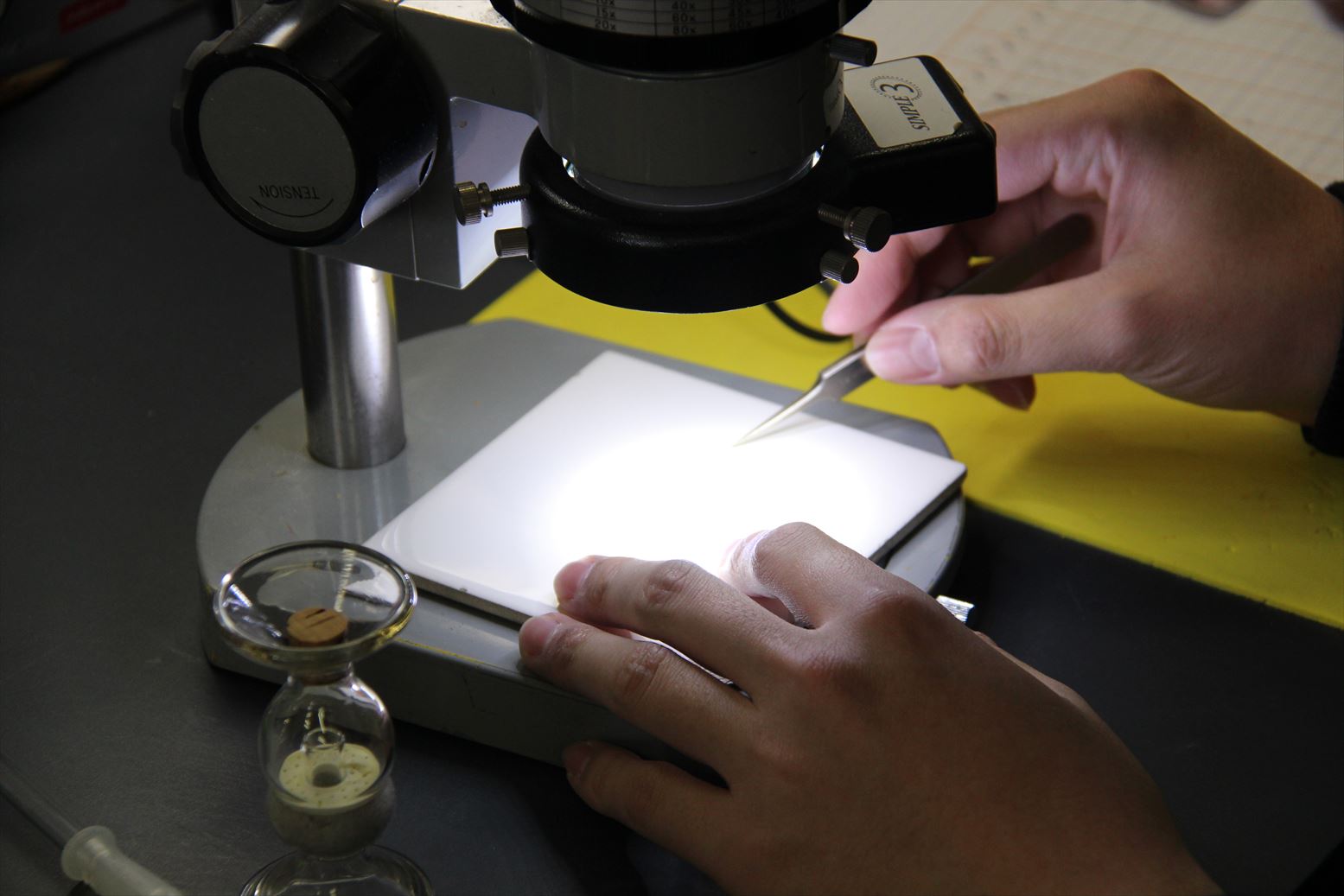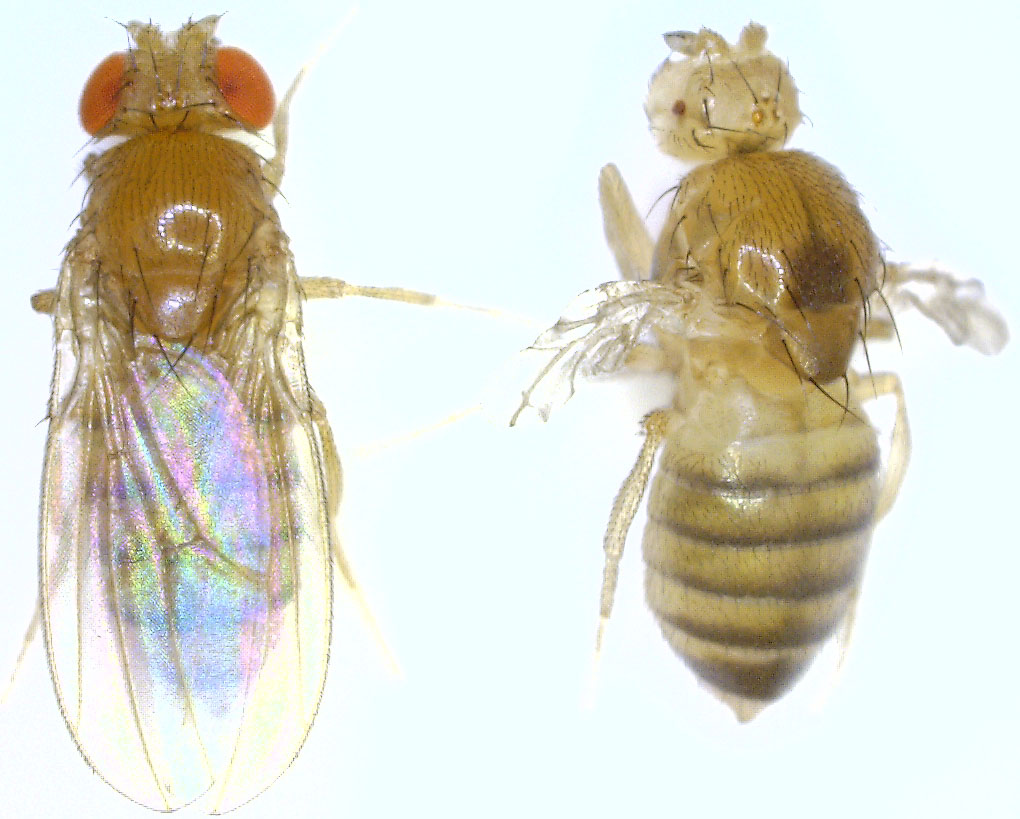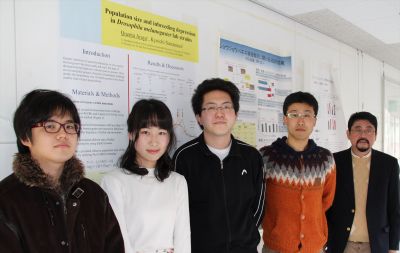TSUKUBA FUTURE
#057 Small Flies Tell Us a Big Story
Associate Professor SAWAMURA Kyoichi, Faculty of Life and Environmental Sciences
When it gets warm, small flies appear in the kitchen from nowhere. Most of these are a type called Drosophila. They love things like kitchen refuse, particularly fruit and vegetable waste, and fermented foods. Flies are hated as pests, so much so that the Japanese word urusai (annoying) literally means "flies of May." However, these flies have made major contributions as experimental animals in the field of genetics. Research on evolutionary genetics is being carried using Drosophila as a model organism.
In biology class, you probably learned about Mendel's laws of inheritance. Mendel discovered his laws by carrying out crossing experiments using green peas. Since then, the development of genetics has been supported by the small fruit flies called Drosophila. This approach appeared at the start of the 1900s in research at the laboratory of the American geneticist Thomas Morgan. Drosophila are a convenient animal model because many can be raised at once in a small glass bottle, and their generation time is only about 10 days. Many of these Drosophila are raised in Prof. Sawamura's laboratory. In the past, he raised many types, but today his main focus is on the most typical variety Drosophila melanogaster and closely related species as the minimal basis needed for research. In the world, there are said to be about 4,000 species closely related to Drosophila. The number of species in Japan alone is thought to number in the low to mid 200s, and even that is quite a lot. The theme of Prof. Sawamura's research is why there are so many types of Drosophila.

The task of the "traditional art" of sorting flies under a stereomicroscope. The funnel-shaped glass container at left is for anesthetizing flies.
The living organisms on the earth have evolved by branching from a common ancestor in the distant past. Many of the types of Drosophila are also thought to have evolved from an ancestral Drosophila. When species branch off, this is accompanied by changes in behavior and physiology. When there are changes in behavior, mating does not even occur in the first place. When there are changes in physiology, mating may occur, but the eggs will not develop normally, or the offspring may be sterile. Underlying such changes should be genetic mutations. Prof. Sawamura is identifying the genes which characterize each species by creating hybrids. He does this by crossing the closely related species which have split apart, trying out various combinations, and then investigating the hybrids' genetic characteristics. The basic work is the same as that carried out in the laboratory of Thomas Morgan 100 years ago. Prof. Sawamura jokingly calls it a "traditional art." In the laboratory, the flies bred in various combinations are anesthetized with ether, and their numbers are counted based on their characteristics while observing them with a microscope. This is a job requiring patience?counting thousands of flies every day. As a result of this research, Prof. Sawamura has gained considerable understanding of mechanisms at the genetic level which divide species. His approach sounds at first like an analog technique, but the entire base sequence of the Drosophila genome was deciphered in 2000, and the functions of the various genes are being identified. Precisely because such a large amount of information has been accumulated, research is closing in on the deep mechanisms of genetics, even in an area where work is done using optical microscopes.

Left: Drosophila melanogaster, wild type, female; Right: Double mutant female (missing compound eyes and wings)
(Photo: Quenta Araye)
The University of Tsukuba has had a tradition of research in entomology and genetics since the era of its forerunner, the Tokyo University of Education. However, it has gone beyond just passing down tradition, and maintained a culture which values diversity of research. Because of that, even within research using the same Drosophila, the topics addressed by each laboratory cover a broad range including genetics, embryology, behavioral studies and endocrinology. There are also other laboratories conducting research on insects. Actually, there is even a Drosophila whose scientific name derives from Tsukuba: Drosophila tsukubaensis. This species was discovered and named by Dr. Hisaki Takamori, currently Associate Professor of Tokyo Gakugei University, when he was a graduate student at the University of Tsukuba.
Prof. Sawamura loved insects as a boy. In his student days, he even traveled overseas in the search for insects. Today, however, he no longer has time for that. When he retires, he says he wants to study some of the mysteries of daily life. For instance, when it gets to be spring, flies appear in the kitchen, but it is not well understood where and how they pass the winter. His retirement is still quite a ways off though, and since three years ago, he has been using his past experience to lead groups of insect collectors on campus as part of the University of Tsukuba "Kids' University" held during Science and Technology Week. During summer vacations, he has also worked as a group leader for insect hunts in Kyoiku no Mori Park on the Tokyo Campus of the University of Tsukuba. In his classes at the university, he lectures on topics such as basic biology experiments and genetics, and teaches courses for teacher licensing. Today, he continues to devote himself to his "traditional art," while passing on the fun of insect collecting to children, the mysteries of biology to his students, and the essence of biology education to science teachers.
Article by Science Communicator at the Office of Public Relations

Members involved in the "traditional art." In front of posters presenting research results.



